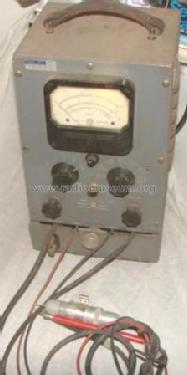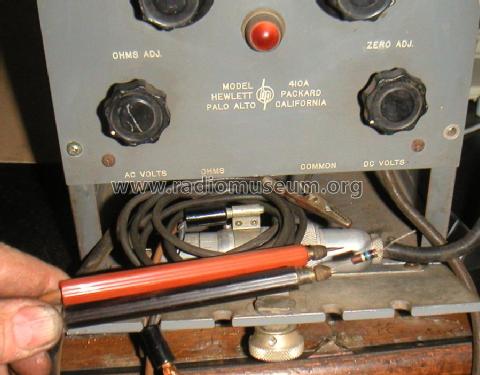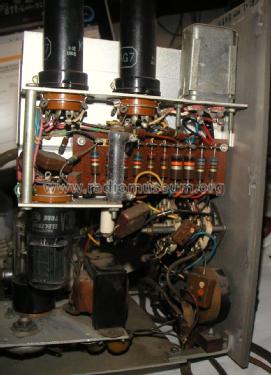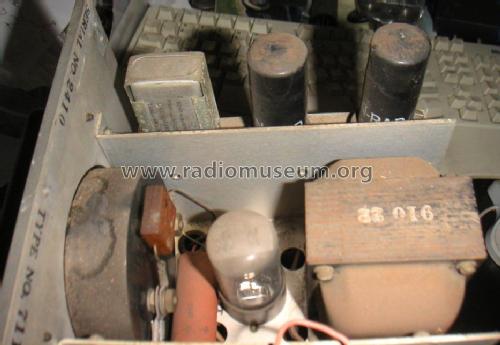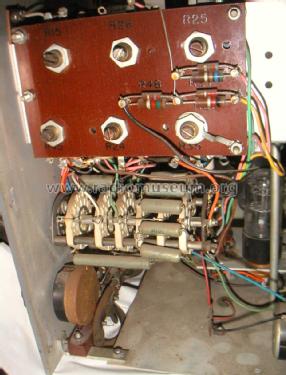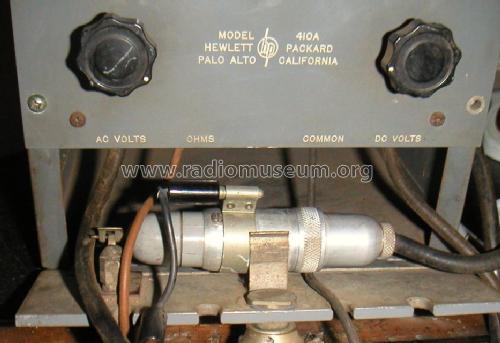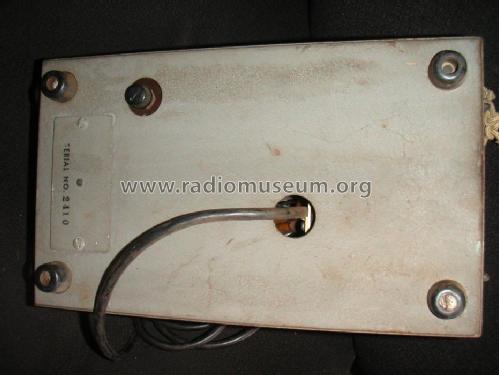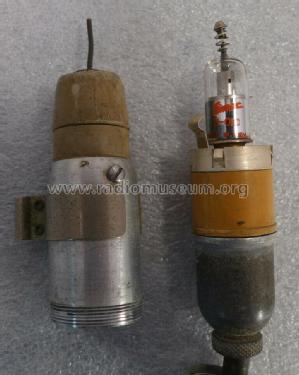HF VTVM 410A
Hewlett-Packard, (HP); Palo Alto, CA
- País
- Estados Unidos
- Fabricante / Marca
- Hewlett-Packard, (HP); Palo Alto, CA
- Año
- 1945–1950 ?
- Categoría
- Aparato de medida y servicio (Equipo de laboratorio).
- Radiomuseum.org ID
- 137028
Haga clic en la miniatura esquemática para solicitarlo como documento gratuito.
- Numero de valvulas
- 6
- Gama de ondas
- - no hay
- Tensión de funcionamiento
- Red: Corriente alterna (CA, Inglés = AC) / 115 & 1,5 Volt
- Altavoz
- - - No hay salida de sonido.
- Material
- Metálico
- de Radiomuseum.org
- Modelo: HF VTVM 410A - Hewlett-Packard, HP; Palo Alto
- Forma
- Sobremesa de tamaño mediano sin botonera <= 35 cm. (Incluso portables pero sólo con alimantación por red).
- Anotaciones
- High Frequency Vacuum Tube Voltmeter; 20 Hz to 700 MHz.
- Procedencia de los datos
- -- Collector info (Sammler)
- Mencionado en
- -- Original-techn. papers.
- Documentación / Esquemas (1)
- -- Schematic
- Autor
- Modelo creado por Gottfried Silberhorn. Ver en "Modificar Ficha" los participantes posteriores.
- Otros modelos
-
Donde encontrará 399 modelos, 367 con imágenes y 139 con esquemas.
Ir al listado general de Hewlett-Packard, (HP); Palo Alto, CA
Colecciones
El modelo HF VTVM es parte de las colecciones de los siguientes miembros.
Contribuciones en el Foro acerca de este modelo: Hewlett-Packard, HP;: HF VTVM 410A
Hilos: 1 | Mensajes: 1
HIGH FREQUENCY VACUUM TUBE VOLTMETER
"From HP Catalog 18A" Laboratory Instruments", Copyrighted 1945."

ADVANTAGES:
Range: 20 cps to 700 mc
Input Capacity 1.3 mmfd
High Input Impedance
Few Controls
High Stability
Rugged Meter Movement
Excellent Overload Protection
Small, Lightweight, Portable
Built-in compartment for Probe and Test Leads
USE IT TO MEASURE:
Audio Frequency, Supersonic R.F.,
and VHF Voltages
Antenna Voltage, Current, and Power
Transmission Line Characteristics
Standing Waves
Audio, Video, and VHF Amplifiers
DC Voltage in High Impedance Circuits
Resistance
Insulation
ALL-PURPOSE TEST INSTRUMENT MEASURES TO 700 MC
Because of the tremendous number of tasks it will perform, the 410A High Frequency Vacuum Tube Voltmeter can play a uniquely valuable role in any laboratory, broadcast station, or production test department. It combines in one instrument an AC voltmeter covering the frequency range from audio to radar frequencies, a DC voltmeter with 100 megohms input impedance, and an ohmmeter capable of measuring resistance from 0.2 ohms to 500 megohms. In addition, it is easy to use, compact, portable, and light in weight.
A special probe, employing a new, radically different diode especially designed by Eimac for Hewlett-Packard, is used for making AC measurements. The resonant frequency of the diode is approximately 2000 Mc, and the shunt capacity is extremely low. Mounted in the probe, it places a capacity of only 1.3 mmfd across the circuit under test. Total input impedance for AC measurements is 6 megohms shunted by this capacity.
The 410A employs a high impedance DC voltmeter having a special circuit developed by -hp- engineers. Its outstanding feature is low drift and maintenance of calibration over long periods of time. Only one zero adjustment is necessary for all voltage ranges, and once set it rarely needs readjustment. This circuit permits the use of a 1 ma meter movement which together with certain features of the circuit itself makes it impossible to damage the meter by overloads. Input impedance for DC measurements is 100 megohms for all ranges.
Frequency response of the instrument is flat within 1 decibel from 20 cps to 700 Mc, and due to the very high resonance frequency of the special diode, voltage indication can be obtained at a frequency of 3000 Mc. Overall accuracy of the instrument on sinusoidal voltages is +3%, and is the same for DC measurements.
USES
The versatility of the 410A is so great that the number of uses to which it may be put is almost endless. As an ohmmeter it will accurately measure resistance over a much wider range than is ever ordinarily encountered. As a DC voltmeter, its extremely high input impedance permits its use on almost any equipment without any appreciable loading of the circuit under test.
As an AC voltmeter, its combination of high input impedance with great frequency range sets altogether new standards of performance. The probe can be inserted in almost any audio, supersonic, radio, or VHF amplifier without detectable loading of the circuit. It can be used to measure antenna and transmission-line voltage, current, and power with as much ease and convenience as if the circuits carried DC. Special adaptors can be supplied for use with the probe to connect to standard transmission lines.
Finally, the fact that all these functions are combined in one instrument means that where previously a whole battery of equipment might be required to test a given piece of apparatus, the 410A, in one small, convenient, and highly portable instrument, does the whole job. Leads are provided for all functions so that to change from one to another it is necessary only to throw a switch.
SPECIFICATIONS
Ranges: 1 to 300 volts in 6 ranges full scale: 1, 3, 10, 30, 100, and 300 volts AC or DC and 0-1000 volt range DC. Resistance 0.2 ohm to 500 megohms in seven ranges. Mid scale reading of 10, 100, 1000, 10,000, 100,000 ohms, 1 megohm, and 10 megohms.
Accuracy: ±3% of full scale on all ranges on sinusoidal AC voltages and on dc voltages. The ac portion of the instrument is essentially a peak-reading device and is calibrated in rms volts.
Frequency Response: Frequency response is flat within +1 db up to 700 mc and drops off less than 1 db at 20 cps. The resonant frequency of the probe input circuit is about 2000 mc, and an indication can be obtained up to 3000 mc.
Input Impedance: Input capacity is 1.3 mmfd ; input resistance is 6 megohms at low frequencies. At high frequencies resistance drops off due to dielectric losses: DC input resistance is 100 megohms for all ranges.
Probe: The probe is approximately 1" diameter and 4¾" long. It is equipped with a ground clip, and the connector may be soldered to the point under test. For operation at lower frequencies the probe can be mounted in the storage compartment and connections made to binding posts on the panel. Adapting connectors are available to measure voltages in coaxial transmission lines.
Power Supply: 115 volts, 50/60 cycles, 40 watts. Two 1½ volt flashlight cells provide ohmmeter circuit voltage.
Mounting: Gray panel in a wrinkle gray finished metal case and provided with a carrying handle. May be operated vertically or lying flat on test bench. A compartment is provided to store the probe and leads. Size 12 1/16 x 7 5/16 x 6 ¼".
Net weight 16 pounds, shipping weight 23 pounds.
Pius Steiner, 24.Sep.12


